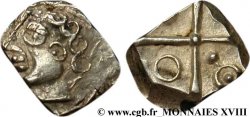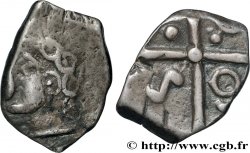- Accueil
- >
- >
v15_0276 - GALLIEN - SÜDWESTGALLIEN - SOTIATES (Region die Sos) Drachme au cheval, “Courantillos”, ANTIIIOS/COVRA
MONNAIES 15 (2002)
Startpreis : 650.00 €
Schätzung : 1 500.00 €
Erzielter Preis : 650.00 €
Anzahl der Gebote : 1
Höchstgebot : 725.00 €
Startpreis : 650.00 €
Schätzung : 1 500.00 €
Erzielter Preis : 650.00 €
Anzahl der Gebote : 1
Höchstgebot : 725.00 €
Type : Drachme au cheval, “Courantillos”, ANTIIIOS/COVRA
Datum: c. 121-52 AC.
Metall : Silber
Durchmesser : 16,5 mm
Stempelstellung : 6 h.
Gewicht : 2,87 g.
Seltenheitsgrad : R3
Kommentare zum Erhaltungszustand:
Exemplaire de qualité exceptionnelle pour ce type de monnayage. Fortement décentré au revers sur la tête et le cou du cheval
N° im Nachschlagewerk :
Pedigree :
Cet exemplaire provient de la collection Theodor Voltz, Auctiones 25, 19-21 juin 1995, n° 1165. Monnaie illustrée dans BOUDEAU II, à la page 58, "Monnaies gauloises en argent"
Vorderseite
Titulatur der Vorderseite ANÉPIGRAPHE.
Beschreibung Vorderseite Tête stylisée allongée à droite avec les cheveux bouclés.
Rückseite
Titulatur der Rückseite COVR[A]/ ANTILLO[S].
Beschreibung Rückseite Cheval sexué galopant à droite.
Kommentare
Flan quadrangulaire taillé au burin. Le grènetis de deux exemplaires juxtaposés est bien visible sur cette drachme. Il présente donc une singularité de fabrication. Au droit, devant le visage principal, on découvre l’arrière d’une chevelure ce qui implique que la lame de métal a été frappée deux fois successives, puis découpée. La technique même de fabrication des monnaies à la croix explique ce “chevauchement” de deux empreintes.
Quadrangular flan cut with a burin. The graining of two juxtaposed examples is clearly visible on this drachma. It therefore presents a manufacturing singularity. On the right, in front of the main face, we discover the back of a head of hair, which implies that the metal blade was struck twice successively, then cut. The very technique of manufacturing cross coins explains this “overlapping” of two impressions
Quadrangular flan cut with a burin. The graining of two juxtaposed examples is clearly visible on this drachma. It therefore presents a manufacturing singularity. On the right, in front of the main face, we discover the back of a head of hair, which implies that the metal blade was struck twice successively, then cut. The very technique of manufacturing cross coins explains this “overlapping” of two impressions








 Berichten über einen Fehler
Berichten über einen Fehler Die Seite drucken
Die Seite drucken Teilen meiner Auswahl
Teilen meiner Auswahl Stellen Sie eine Frage
Stellen Sie eine Frage Einlieferung/Verkauf
Einlieferung/Verkauf
 Details
Details










